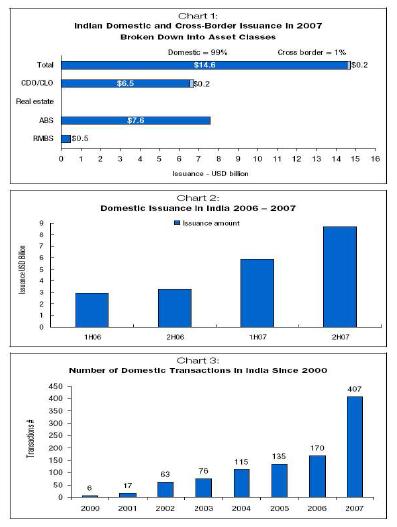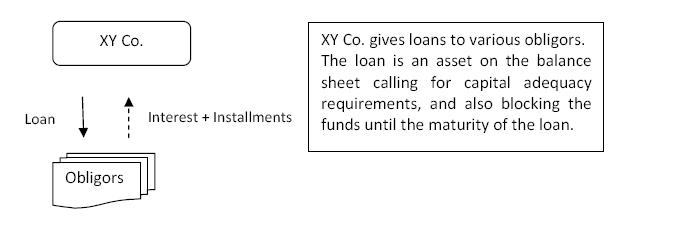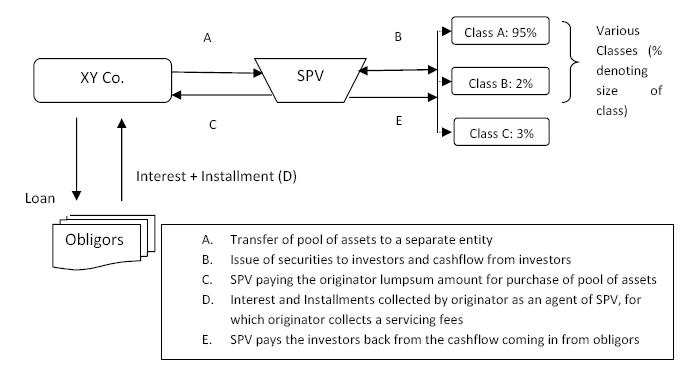 Structured Finance Market
Structured Finance Market
The structured finance market in India has grown over the years. A brief picture of the structured finance market considering only the listed transaction is depicted through the graphs alongside¹. The graphs show a rise in structured finance market in the year 2007, however now the markets have significantly fallen down after recent turmoil in the finance industry. The investors have become reluctant in investing; specially after witnessing the market volatilities caused due to events like subprime crisis, failure of top investment banks. The loss of investor’s faith has reduced the structured finance growth not only in India but all over the world.
Nonetheless asset backed funding or securitisation cannot loose its relevance since the growth of the economy shall be always indebted to the contributions of structured finance. Definitely there may be attempts for stricter vigilance inviting a change in the accounting treatment, rating standards or so. Like, questions are already being raised on the off balance sheet treatment of securitized assets, and may be in the time to come securitized assets will be on the balance sheet of the originator. Let us have a closer look at the finer mode of raising funds: Securitisation.
Securitisation: Brief Introduction
Securitisation, as the name suggests implies creation of securities. Theoretically speaking, securitisation is conversion of assets into securities; such securities are issued to willing investors, who in-turn get a pay through (bond type structure) or pass through (equity type structure) interest in the asset. In other words securitisation is creation of security by taking the asset out in the market, hence creating a capital market window and immediate liquidity for the holder of assets. Though it seems like but securitisation is not financing; the entity securitising its assets is not borrowing money but selling a stream of cashflows that was otherwise to accrue to it.
Process of Securitisation
A more lucid picture of securitisation is below:
- Introduction to originator: An entity which securitizes its assets is the Originator. Usually an originator transfers the pool of assets to a special purpose vehicle which in turn issues securities. The typical originators are Mortgage financiers, Bank loans, Finance companies, Credit card companies, Hoteliers, rentiers, Public utilities etc. For the purpose of illustration let us assume a mortgage funding company ‘XY Mortgage Finance Limited’ or XY Co. with a number of receivables, which it intends to securitise.
- Familiarity with Special Purpose Vehicle (SPV): The originator transfers the pool of assets to a special purpose vehicle, which is a non-discretionary body in form of a company or trust. Supposedly the pool of receivables is USD 100 million; and the rate of return that SPV would now receive on the loans is 8.55% which is the weighted average of the interest accruing on the loans.
- Issuance of securities to investors: The SPV holds the pool and issues securities on the strength of the pool. The SPV uses the funds raised by issue of securities to pay off the originator for purchase of the pool. Hence the originator gets liquidity for the assets which may be maturing only after a considerable span of time. The investors of the securities have a direct interest in the pool of assets, and the SPV uses the cashflows from receivables to repay investors of securities. The securities issued by the SPV are structured into different classes of securities, wherein junior classes act as a cushion to absorb losses allowing higher rating for senior classes. Let us assume three classes of securities are being offered at different coupon rates, Class A being the cheapest. Let us suppose the weighted average cost of the coupons comes to 7%.
- Servicer Role: SPV is almost like a non-substantive shell, it cannot do the collection and servicing function itself. Generally, the originator himself retains the servicing function since he has proximity with the obligors and has necessary infrastructure and systems for doing so. The originator acts as a servicer and collects interest and installments from the obligor along with other allied services for which it receives a fee. Let us assume a fee for services of originator is 50 bps.
- Reinvestment: The cashflows collected month after month by the servicer are used to repay the securities, either with or without reinvestment. If the structure of bonds issued is pay-through then the cashflows from the pool of assets may be reinvested and the investors are paid only at a particular time. However if the bonds are pass-through then the cashflows from the pool of assets are only used for payment to the investors.
- Excess Spread: It is the excess of the income flowing from pool of assets, over and above the coupon payable to the investors and the expenses of the transaction. The residual interest may be held either by the originator itself, or may be sold to willing buyers. In the instant case the excess spread is as follows:
- Absorption of Losses: Each securitisation transaction has some kind of credit enhancement, to get the desired rating for the securities. Credit enhancement may be structural such as subordination, excess spread or it may be third party guarantee etc. The junior classes of securities issued by SPV act as a credit enhancer for the senior classes. Excess spread also acts as a credit enhancement, it is only when the excess spread is wiped out by losses then the junior classes are affected. The most junior class is the first one to absorb loss after the excess spread is wiped out, hence many a times junior class doesn’t find a buyer and is retained by originator.
- Benefits: Let us see how securitising the pool of receivables is advantageous in the instant case:



Excess Spread= 8.55 – 7 – 0.50 = 1.05%
- On day 1 the originator got funding of USD 100 million. The junior most or least rated class of securities issued by SPV, in the instant case Class C is usually retained by the originator himself so the actual funding of originator is only USD 97 million (Class C being 3%).
- In addition, he gets the residual interest in the transaction, representing the cash left over after paying all investors. Thus the transaction helps to earn excess spread.
- The investor got 3 different classes of securities to pick up, each carrying a different rating and a different coupon rate. Since the pool of assets is isolated from the main identity, hence the underlying assets for the securities are free from liabilities accruing to the originator.
- The SPV was a creature designed for enabling the entire show – so, no regrets that the SPV gets nothing at all.
Regulatory Outline
India has a specific set of guidelines regulating securitisation transaction dated February 2006. However these guidelines are not mandatory, but non adherence to them may lead to disallowance of capital relief. Further master circular on Basel II issued in June 2008 also lay down norms for securitisation exposures.
¹ The graphs have been extracted from Moody’s Report on Structured finance in India: Growth Countries dated March 2008
